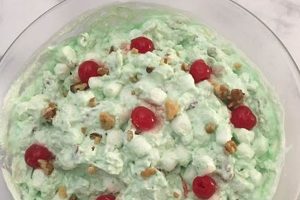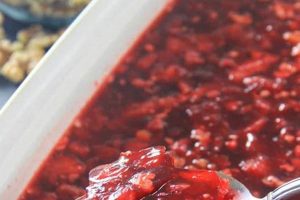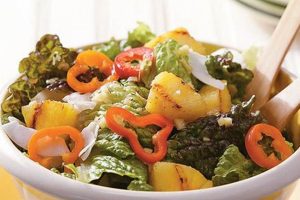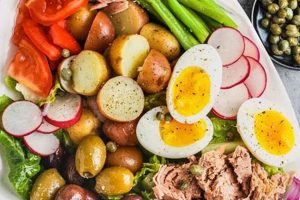A blend of cream cheese, cranberries, and often additional ingredients like pecans, walnuts, or orange zest creates a sweet and tangy spread or salad. This dish commonly appears as a side at holiday meals or as a spread for sandwiches and crackers. Variations exist, incorporating different sweeteners, spices, or textures, allowing for customization based on personal preferences or dietary needs.
The dish offers a balance of flavors and textures, appealing to diverse palates. Its versatility allows it to complement various cuisines and occasions. Historically, cranberries, a North American fruit, have held significance in festive meals, and their inclusion in cream cheese salads solidifies this tradition. This dish is relatively simple to prepare, requiring minimal culinary expertise, and offering the opportunity for creative modifications. The inclusion of fresh ingredients provides nutritional value, including vitamins and antioxidants from the cranberries.
This exploration will delve into various aspects of this culinary creation, including detailed ingredient lists, step-by-step instructions for diverse variations, nutritional information, and serving suggestions for different events.
Tips for Cranberry Cream Cheese Salad Preparation
Achieving optimal flavor and texture requires attention to detail. These tips offer guidance for creating a successful cranberry cream cheese salad.
Tip 1: Cranberry Selection: Fresh or frozen cranberries work well. Dried cranberries, while convenient, may result in a sweeter, chewier texture. If using frozen cranberries, ensure they are fully thawed and drained before incorporating them into the mixture.
Tip 2: Cream Cheese Consistency: Allow cream cheese to soften at room temperature for easier blending. Avoid over-softening, as this can result in a runny salad. Full-fat cream cheese provides a richer flavor and texture.
Tip 3: Sweetener Choices: Granulated sugar, powdered sugar, or honey can be used to sweeten the salad. Adjust the amount according to personal preference and the sweetness of the cranberries. Taste-testing is crucial.
Tip 4: Flavor Enhancement: Orange zest, chopped pecans or walnuts, and a dash of cinnamon or nutmeg can elevate the flavor profile. Consider a small amount of orange liqueur or vanilla extract for added complexity.
Tip 5: Mixing Techniques: A hand mixer or stand mixer ensures a smooth, evenly distributed mixture. Overmixing can lead to a gummy texture. If mixing by hand, ensure the cream cheese is adequately softened.
Tip 6: Chill Time: Chilling the salad for at least an hour allows the flavors to meld and the texture to firm up. This is particularly important if using fresh cranberries.
Tip 7: Presentation: Serve the cranberry cream cheese salad on crackers, crusty bread, or as part of a cheese and fruit platter. Garnish with fresh cranberries, chopped nuts, or a sprig of mint for an elegant touch.
By following these tips, one can create a cranberry cream cheese salad that balances sweetness, tartness, and texture, offering a delightful culinary experience.
These insights provide a foundation for creating and enjoying cranberry cream cheese salad. The following sections will delve into specific recipes and variations.
1. Ingredients
Ingredients form the foundation of any cranberry cream cheese salad recipe. The selection and quality of each ingredient directly impact the final product’s flavor, texture, and overall appeal. Consideration of ingredient interactions is crucial. For instance, the tartness of cranberries requires balancing sweetness from sugar or other sweeteners. The richness of cream cheese provides a base for these contrasting flavors to harmonize. Ingredient quality affects the overall sensory experience. Fresh, high-quality cranberries contribute a brighter, more vibrant flavor compared to older or processed alternatives. Similarly, using full-fat cream cheese results in a creamier, richer texture than low-fat versions.
Specific ingredient choices allow for recipe customization. The addition of pecans or walnuts introduces textural contrast and nutty undertones. Orange zest contributes a citrusy brightness that complements the cranberry’s tartness. Dried cranberries offer a chewier texture and concentrated sweetness compared to fresh cranberries. These choices allow adaptation to personal preferences and dietary needs. Substituting honey for sugar offers a natural sweetener option. Adapting ingredient quantities allows control over sweetness and tartness levels. Understanding these ingredient interactions provides a framework for informed recipe adjustments and creative variations.
Ingredient selection is paramount to crafting a successful cranberry cream cheese salad. Careful consideration of individual ingredient characteristics and their interplay allows for predictable manipulation of flavor and texture. This understanding empowers culinary creativity, facilitating personalized recipes optimized for individual preferences and desired outcomes. Utilizing fresh, high-quality ingredients elevates the final product, offering a superior sensory experience. Further exploration of specific ingredient combinations and their impact on the overall profile offers a pathway to mastering this versatile dish.
2. Proportions
Proportions play a crucial role in achieving a balanced and palatable cranberry cream cheese salad. The ratio of cream cheese to cranberries influences both the flavor profile and the overall texture. Too much cream cheese can mask the cranberry’s tartness, resulting in an overly rich and bland salad. Conversely, an excessive amount of cranberries can create an excessively tart and potentially dry mixture. Achieving the desired balance requires careful consideration of ingredient ratios.
Specific proportions depend on the desired outcome and recipe variations. A standard recipe might call for equal parts cream cheese and cranberries, providing a balance of sweetness and tartness. However, adjusting these proportions allows for customization. Increasing the cream cheese creates a milder, creamier salad, while increasing the cranberries intensifies the tart flavor. The addition of other ingredients, such as nuts or sweeteners, further necessitates proportional adjustments. For example, adding chopped pecans requires a slight reduction in the cranberry quantity to maintain textural balance. Similarly, incorporating a sweeter element like dried cranberries necessitates a decrease in added sugar to prevent excessive sweetness.
Understanding proportional relationships empowers culinary control over the final product. It allows for predictable manipulation of flavor profiles and textural nuances. Mastering these ratios allows for consistent results and facilitates creative exploration within the recipe framework. Careful consideration of proportions elevates the cranberry cream cheese salad from a simple mixture to a well-balanced, nuanced culinary creation.
3. Mixing Method
Mixing method significantly influences the final texture and consistency of cranberry cream cheese salad. Different methods produce distinct results, ranging from a smooth, homogenous blend to a coarser, chunkier texture. Selection of the appropriate method depends on the desired outcome and personal preference.
Hand mixing, using a spatula or spoon, creates a salad with more texture. Cranberry pieces remain largely intact, providing a noticeable chewiness. This method is ideal for those who prefer a less processed, more rustic feel. Electric mixing, using a stand or hand mixer, yields a smoother, more homogenous result. Cranberries are broken down further, resulting in a creamier, more spreadable consistency. This method is preferred for those seeking a uniform texture and easier incorporation into dips or spreads.
The degree of mixing also plays a role. Overmixing, regardless of the method, can lead to a gummy or dense texture. Careful attention to mixing time ensures optimal results. Understanding the impact of mixing method allows for deliberate control over the final product. Choosing the appropriate method and monitoring mixing time empowers creation of a cranberry cream cheese salad with the desired textural qualities, whether smooth and creamy or chunky and rustic. This understanding contributes significantly to a successful and enjoyable culinary experience.
4. Chill Time
Chill time constitutes a critical step in cranberry cream cheese salad preparation. Allowing the mixture to rest in a refrigerated environment for a specific duration yields several notable benefits, impacting both flavor and texture. This chilling period facilitates the melding and intensification of flavors. The initially disparate ingredientscream cheese, cranberries, sweeteners, and any additional flavoringsharmonize during this time. The cold temperature slows down enzymatic activity, preserving the fresh flavors of the components while allowing them to integrate more fully. This results in a more cohesive and complex flavor profile compared to a freshly mixed salad.
Texture also benefits significantly from chill time. The cold temperature firms the cream cheese, enhancing the salad’s overall structure and stability. This is particularly important if the cream cheese was softened significantly prior to mixing. Chilling prevents the salad from becoming excessively runny or loose, ensuring a desirable spreadable consistency. This improved texture contributes to a more pleasing mouthfeel and enhances presentation, especially when served on crackers or as a sandwich spread. Without adequate chill time, the salad might be too soft to hold its shape or spread neatly.
Practical application demonstrates the significance of chill time. A freshly mixed cranberry cream cheese salad, while edible, often lacks the depth of flavor and optimal texture achieved through chilling. The flavors may taste somewhat disjointed, and the texture might be less appealing. Conversely, a properly chilled salad presents a harmonious blend of flavors and a desirable texture. Challenges related to chill time include time management and temperature control. Insufficient chilling results in suboptimal flavor and texture development, while excessive chilling can make the salad too firm to spread easily. Therefore, adherence to recommended chill times, typically one to two hours, is crucial for optimal results. Understanding the impact of chill time contributes significantly to successful cranberry cream cheese salad preparation, ensuring a dish that offers both satisfying flavor and appealing texture.
5. Serving Suggestions
Serving suggestions enhance the enjoyment of cranberry cream cheese salad by providing diverse options for presentation and pairings. Thoughtful consideration of serving methods elevates the dish beyond a simple mixture to a versatile culinary component, suitable for various occasions and palates. The following explores several serving suggestions, highlighting their respective characteristics and suitability.
- Crackers or Crostini:
Crackers or crostini provide a crisp, neutral base that allows the flavors of the cranberry cream cheese salad to shine. The textural contrast between the creamy salad and the crunchy cracker or crostini enhances the sensory experience. Variety in cracker or crostini selection, from plain water crackers to seeded or herbed varieties, further customizes the flavor profile. This serving method is particularly well-suited for appetizers, snacks, or casual gatherings.
- Sandwiches or Wraps:
Cranberry cream cheese salad functions as a flavorful spread for sandwiches and wraps. Paired with turkey, ham, or roasted chicken, it adds a sweet and tangy counterpoint to savory fillings. Leafy greens and other vegetables can be incorporated to add freshness and texture. This option offers a portable and satisfying meal suitable for lunches, picnics, or quick dinners.
- Fruit Platters or Cheese Boards:
Incorporating cranberry cream cheese salad into fruit platters or cheese boards adds a creamy, flavorful element. Its sweetness and tartness complement a range of fruits, from apples and grapes to berries and melon. The salad’s color and texture also contribute visual appeal to the presentation. This serving style is ideal for parties, holidays, or brunches.
- Stuffed Dates or Celery Sticks:
For a lighter, more bite-sized presentation, cranberry cream cheese salad can be used to stuff Medjool dates or fill celery sticks. This option offers a balance of sweet and savory flavors and provides a visually appealing appetizer or snack. The natural sweetness of dates complements the tartness of the cranberries, while the crisp celery offers a refreshing contrast to the creamy filling.
These varied serving suggestions demonstrate the versatility of cranberry cream cheese salad. Whether served as a simple spread, a sandwich filling, or a component of a larger platter, the salad adapts to various culinary contexts, enhancing both flavor and presentation. Consideration of these serving methods expands the potential of this versatile dish, offering a range of options for different occasions and preferences. From casual snacks to elegant appetizers, the adaptability of cranberry cream cheese salad makes it a valuable addition to any culinary repertoire.
6. Variations
Variations within the cranberry cream cheese salad recipe demonstrate the adaptability of this dish, expanding its potential beyond a basic formulation. Modifying ingredients introduces complexity and caters to diverse palates and dietary requirements. These variations stem from ingredient substitutions or additions, impacting flavor profiles, textures, and nutritional values. Cause-and-effect relationships underpin these variations. For instance, substituting dried cranberries for fresh cranberries results in increased sweetness and a chewier texture. Adding pecans introduces a contrasting crunch and nutty flavor. These deliberate ingredient changes predictably alter the sensory experience.
Variations constitute an essential component of the cranberry cream cheese salad repertoire. They elevate the dish from a simple combination of ingredients to a customizable platform for culinary expression. Real-life examples illustrate this concept. A variation featuring orange zest and walnuts provides a festive, citrusy twist. A version incorporating jalapeos offers a spicy kick. Sugar-free variations cater to specific dietary needs. These examples showcase the practical significance of understanding variations, enabling adaptation to individual preferences and specific occasions.
Understanding the impact of ingredient modifications empowers informed recipe adjustments. This knowledge allows for predictable manipulation of flavor profiles, textures, and nutritional content. Challenges related to variations include maintaining balance. Excessive additions or substitutions can compromise the integrity of the dish. However, careful consideration of ingredient interactions and proportions ensures successful variations. Exploring variations contributes to a richer culinary experience, broadening the appeal and versatility of cranberry cream cheese salad. It transforms the dish from a static recipe into a dynamic culinary concept.
Frequently Asked Questions
This section addresses common inquiries regarding cranberry cream cheese salad preparation and variations.
Question 1: Can frozen cranberries be used in this recipe?
Frozen cranberries are suitable. Thawing and thorough draining are crucial before incorporation to prevent excess moisture, which can affect the salad’s texture and consistency. Adjustments to sweetener quantities might be necessary due to potential variations in cranberry sweetness.
Question 2: What can be substituted for cream cheese?
While cream cheese provides the characteristic flavor and texture, Neufchtel cheese, a lower-fat alternative, can be substituted. Greek yogurt, while offering a tangier flavor, can also serve as a base, particularly in variations emphasizing a lighter profile. These substitutions may impact the final texture and richness of the salad.
Question 3: How long can cranberry cream cheese salad be stored?
Refrigeration in an airtight container allows for storage up to five days. Maintaining consistent refrigeration temperature minimizes spoilage risk. Observing any changes in appearance, texture, or odor is crucial before consumption, discarding the salad if any signs of spoilage are present.
Question 4: Can this salad be made ahead of time for events?
Preparing the salad one to two days in advance is feasible. Storage in an airtight container within a refrigerator preserves flavor and texture. Allowing the salad to reach serving temperature before presentation enhances flavor perception and optimal spreadability.
Question 5: How can the sweetness be adjusted?
Sweetness levels are adjusted by modifying sugar or sweetener quantities. Tasting and adjusting incrementally allows for personalized sweetness. Factors influencing sweetness include cranberry type (fresh versus dried) and chosen sweetener (granulated sugar, honey, etc.).
Question 6: What are common allergens in this recipe and how can they be addressed?
Dairy, in the form of cream cheese, is a potential allergen. Substitutions using dairy-free cream cheese alternatives offer a solution for those with dairy sensitivities. Nut allergies, if recipes include nuts, require careful nut omission or substitution with alternatives like sunflower seeds or pumpkin seeds.
These responses offer guidance for common inquiries regarding cranberry cream cheese salad preparation and adaptation. Careful consideration of these points enhances the likelihood of a successful and enjoyable culinary outcome.
The subsequent sections will delve further into specific recipe variations and nutritional information.
Conclusion
Exploration of cranberry cream cheese salad recipes reveals a versatile dish adaptable to various palates and occasions. Ingredient selection, proportions, mixing methods, and chill time significantly influence the final product. Understanding these factors empowers creation of a balanced, flavorful, and texturally pleasing salad. Variations, stemming from ingredient substitutions and additions, further expand the recipe’s potential, catering to diverse preferences and dietary needs. Serving suggestions highlight the salad’s adaptability, from simple spreads on crackers to elegant inclusions on cheese boards. Addressing common inquiries provides practical guidance for successful preparation and storage.
Culinary exploration extends beyond strict adherence to a single recipe. Understanding the underlying principles of flavor and texture interplay allows for informed experimentation and personalized adaptations. This approach transforms the cranberry cream cheese salad from a static recipe into a dynamic culinary concept, offering continued exploration and enjoyment.






